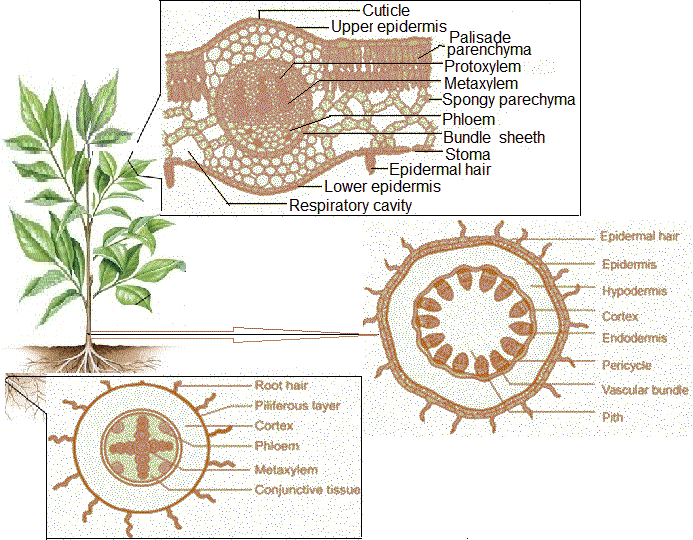Anatomy - The plant tissues system
The tissues system based on the types of cells present and their location in the plant body. Their structure and function would also be dependent on location.
On the basis of their structure and location, there are three types of tissue systems as follows:
The list of tissue names and functions under each system.
| Tissue system | Tissues present | Functions |
|---|---|---|
| Epidermal tissue system | Epidermis, trichomes, hairs, stomata | Protection and prevention of water loss |
| Ground tissue system | Parenchyma, collenchyma, sclerenchyma, mesophyll | Photosynthesis, food storage, protection, support and regeneration |
| Vascular tissue system | Xylem, phloem, cambium | Tansport of food, water and minerals |

Epidermal Tissue System
The epidermal tissue system forms the outermost covering of the whole plant body and comprises epidermal cells, stomata and the epidermal appendages.
It is made up of elongated, compactly arranged cells, which form a continuous layer. Epidermis is usually singlelayered. Epidermal cells are parenchymatous with a small amount of cytoplasm lining the cell wall and a large vacuole.
The outside of the epidermis is often covered with a waxy thick layer called the Cuticle which prevents the loss of water.
Cuticle is absent in roots.
Stomata are structures present in the epidermis of leaves. Stomata regulate the process of transpiration and gaseous exchange. Each stoma is composed of two beanshaped cells known as guard cells which enclose stomatal pore.
In grasses, the guard cells are dumb-bell shaped. The outer walls of guard cells (away from the stomatal pore) are thin and the inner walls (towards the stomatal pore) are highly thickened. The guard cells possess chloroplasts and regulate the opening and closing of stomata.
Sometimes few epidermal cells, in the vicinity of the guard cells become specialised in their shape and size and are known as subsidiary cells. The stomatal aperture, guard cells and the surrounding subsidiary cells are together called stomatal apparatus. The cells of epidermis bear a number of hairs.
The root hairs are unicellular elongations of the epidermal cells and help absorb water and minerals from the soil.
On the stem the epidermal hairs are called trichomes. The trichomes in the shoot system are usually multicellular.
They may be branched or unbranched and soft or stiff. They may even be secretory. The trichomes help in preventing water loss due to transpiration.
Ground Tissue System
All tissues except epidermis and vascular bundles constitute the ground tissue.
It consists of simple tissues such as parenchyma, collenchyma and sclerenchyma.
Parenchymatous cells are usually present in cortex, pericycle, pith and medullary rays, in the primary stems and roots.
In leaves, the ground tissue consists of thin-walled chloroplast containing cells and is called mesophyll.
Vascular Tissue System
The vascular system consists of complex tissues, the phloem and the xylem. The xylem and phloem together constitute vascular bundles.
In dicotyledonous stems, cambium is present between phloem and xylem. Such vascular bundles because of the presence of cambium possess the ability to form secondary xylem and phloem tissues, and hence are called open vascular bundles.
In the monocotyledons, the vascular bundles have no cambium present in them. Therefore they do not form secondary tissues they are referred to as closed.
When xylem and phloem within a vascular bundle are arranged in an alternate manner along the different radii, the arrangement is called radial such as in roots.
In conjoint type of vascular bundles, the xylem and phloem are jointly situated along the same radius of vascular bundles. Such vascular bundles are common in stems and leaves.
The conjoint vascular bundles usually have the phloem located only on the outer side of xylem.
